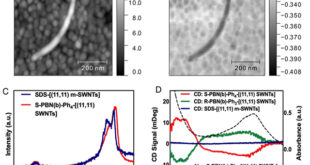Significance Statement
Nitroxide-mediated polymerization (NMP) is the first method adopted to gain control over the free radical polymerization. Via this method, controlled molecular weight, its distribution, and block copolymers may be accessed. Nitroxides may be applied as mediators to an initiator such as benzoyl peroxide, or as initiators themselves. Although alternative methods such as reversible addition fragmentation polymerization lead to better control and even higher molecular weights with narrow distributions, nitroxide-mediated polymerization is exceptionally simple in its practical application.
Professor Eike G. Hübner and his student Felix Lederle from the Clausthal University of Technology in Germany analyzed the addition of poly(2,2,6,6-tetramethylpiperidine-N-oxyl-4-yl methacrylate) (PTMA) to the radical polymerization of styrene. PTMA was prepared by group transfer polymerization. The motivation of their study was to evaluate the influence of PTMA on the polymerization of styrene when compared to the nitroxide-mediated polymerization with conventional 2,2,6,6-tetramethylpiperidine-N-oxyl (TEMPO). Their work is published in the peer-reviewed journal, Polymer.
To understand the effect of PTMA on the polymerization, styrene was polymerized with benzoyl peroxide. For comparison, similar conditions were adopted for the free radical polymerization, the controlled polymerization in presence of TEMPO and the polymerization in presence of PTMA.
To gain more understanding of the polymerization process, the authors compared the molecular weight of the products obtained. In the presence of PTMA, a mixture of low and high molecular weight polymers was formed, which could be characterized by size exclusion chromatography and light scattering.
Molecular weights of the low molecular weight fraction were measured using size exclusion chromatography measurements. The authors found that increasing polymerization time did not result in the increase of the molecular weight. The molecular weight distribution was broad and the polymer was confirmed to be formed by uncontrolled radical polymerization. In contrast, the highest molecular weight fraction was analyzed via dynamic light scattering and the formation of large polymer brushes was recognized.
The conveniently accessible polyradical PTMA has shown to significantly affect the free radical polymerization of styrene. Although PTMA was not efficient in the controlled polymerization of styrene, the formation of the graft copolymer PTMA-g-PS via the grafting-to approach in the polymerization with PTMA offered a convenient approach to bottle-brush polymers.
The free radical polymerization process is technically used to produce various linear polymers for all-day use by the ton via free radical polymerization. The simple addition of a small amount of PTMA converts the free radical polymerization into a source of polymer brushes. The resulting mixture of conventional linear polymer and polymer brushes is expected to provide interesting mechanical, thermal and other physical properties.
This study shows that polymerization in the presence of poly(2,2,6,6-tetramethylpiperidine-N-oxyl-4-yl methacrylate) provides a convenient method to the multigram-scale production of bottle-brush polymers.

Reference
Felix Lederle and Eike G. Hübner. Radical polymerization of styrene in presence of poly(2,2,6,6-tetramethylpiperidine-N-oxyl-4-yl methacrylate) – formation of polymer brushes. Polymer, volume 111 (2017), pages 258-264.
Institute of Organic Chemistry, Clausthal University of Technology, Leibnizstr. 6, D-38678 Clausthal-Zellerfeld, Germany.
Go To Polymer Advances in Engineering Advances in Engineering features breaking research judged by Advances in Engineering advisory team to be of key importance in the Engineering field. Papers are selected from over 10,000 published each week from most peer reviewed journals.
Advances in Engineering Advances in Engineering features breaking research judged by Advances in Engineering advisory team to be of key importance in the Engineering field. Papers are selected from over 10,000 published each week from most peer reviewed journals.



